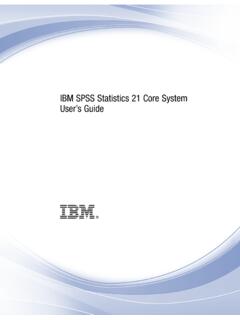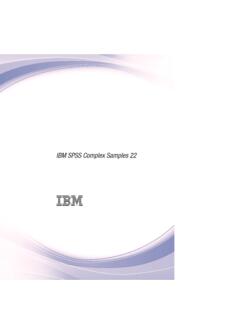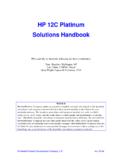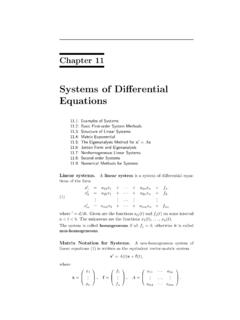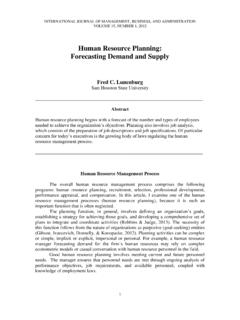Transcription of IBM SPSS Forecasting 22 - University of Sussex
1 IBM spss Forecasting 22 NoteBefore using this information and the product it supports, read the information in Notices on page InformationThis edition applies to version 22, release 0, modification 0 of IBM spss Statistics and to all subsequent releases andmodifications until otherwise indicated in new 1. Introduction to Time Series . 1 Time Series and Validation Models and Producing 2. Time Series Options for the Expert Selection and Event Outliers with the Expert Modeler .. 5 Custom Exponential Smoothing ARIMA Specification for Custom ARIMA Models . 7 Transfer Functions in Custom ARIMA Models.
2 8 Outliers in Custom ARIMA and Forecast Output to the Best- or Model Predictions and Model Specifications Command Additional 3. Apply Time Series Models and Forecast Output to the Best- or Model Predictions and Model Specifications Command Additional 4. Seasonal Decomposition .. 21 Seasonal Decomposition Command Additional 5. Spectral Command Additional 6. Goodness-of-Fit Measures 25 Chapter 7. Outlier 8. Guide to ACF/PACF Plots .. spss Forecasting 22 Chapter 1. Introduction to Time SeriesAtime seriesis a set of observations obtained by measuring a single variable regularly over a period oftime.
3 In a series of inventory data, for example, the observations might represent daily inventory levelsfor several months. A series showing the market share of a product might consist of weekly market sharetaken over a few years. A series of total sales figures might consist of one observation per month formany years. What each of these examples has in common is that some variable was observed at regular,known intervals over a certain length of time. Thus, the form of the data for a typical time series is asingle sequence or list of observations representing measurements taken at regular 1. Daily inventory time seriesTimeWeekDayInventory of the most important reasons for doing time series analysis is to try to forecast future values of theseries.
4 A model of the series that explained the past values may also predict whether and how much thenext few values will increase or decrease. The ability to make such predictions successfully is obviouslyimportant to any business or scientific Series DataWhen you define time series data for use with the Forecasting add-on module, each series corresponds toa separate variable. For example, to define a time series in the Data Editor, click theVariable Viewtaband enter a variable name in any blank row. Each observation in a time series corresponds to a case (arow in the Data Editor).If you open a spreadsheet containing time series data, each series should be arranged in a column in thespreadsheet.
5 If you already have a spreadsheet with time series arranged in rows, you can open itanyway and use Transpose on the Data menu to flip the rows into TransformationsA number of data transformation procedures provided in the Core system are useful in time Define Dates procedure (on the Data menu) generates date variables used to establish periodicityand to distinguish between historical, validation, and Forecasting periods. Forecasting is designed towork with the variables created by the Define Dates Create Time Series procedure (on the Transform menu) creates new time series variables asfunctions of existing time series variables.
6 It includes functions that use neighboring observations forsmoothing, averaging, and differencing. Copyright IBM Corporation 1989, 20131vThe Replace Missing Values procedure (on the Transform menu) replaces system- and user-missingvalues with estimates based on one of several methods. Missing data at the beginning or end of aseries pose no particular problem; they simply shorten the useful length of the series. Gaps in themiddle of a series (embeddedmissing data) can be a much more serious theCore System User's Guidefor detailed information concerning data transformations for time and Validation PeriodsIt is often useful to divide your time series into anestimation,orhistorical, period and develop a model on the basis of the observations in the estimation (historical) period and then test itto see how well it works in the validation period.
7 By forcing the model to make predictions for pointsyou already know (the points in the validation period), you get an idea of how well the model does cases in the validation period are typically referred to as holdout cases because they are held-backfrom the model-building process. The estimation period consists of the currently selected cases in theactive dataset. Any remaining cases following the last selected case can be used as holdouts. Once you'resatisfied that the model does an adequate job of Forecasting , you can redefine the estimation period toinclude the holdout cases, and then build your final Models and Producing ForecastsThe Forecasting add-on module provides two procedures for accomplishing the tasks of creating modelsand producing Chapter 2, Time Series Modeler, on page 3 procedure creates models for time series, andproduces forecasts.
8 It includes an Expert Modeler that automatically determines the best model foreach of your time series. For experienced analysts who want a greater degree of control, it alsoprovides tools for custom model Chapter 3, Apply Time Series Models, on page 15 procedure applies existing time seriesmodels--created by the Time Series Modeler--to the active dataset. This allows you to obtain forecastsfor series for which new or revised data are available, without rebuilding your models. If there's reasonto think that a model has changed, it can be rebuilt using the Time Series spss Forecasting 22 Chapter 2.
9 Time Series ModelerThe Time Series Modeler procedure estimates exponential smoothing, univariate AutoregressiveIntegrated Moving Average (ARIMA), and multivariate ARIMA (or transfer function models) models fortime series, and produces forecasts. The procedure includes an Expert Modeler that attempts toautomatically identify and estimate the best-fitting ARIMA or exponential smoothing model for one ormore dependent variable series, thus eliminating the need to identify an appropriate model through trialand error. Alternatively, you can specify a custom ARIMA or exponential smoothing are a product manager responsible for Forecasting next month's unit sales and revenue foreach of 100 separate products, and have little or no experience in modeling time series.
10 Your historicalunit sales data for all 100 products is stored in a single Excel spreadsheet. After opening your spreadsheetin IBM spss Statistics, you use the Expert Modeler and request forecasts one month into the Expert Modeler finds the best model of unit sales for each of your products, and uses those modelsto produce the forecasts. Since the Expert Modeler can handle multiple input series, you only have to runthe procedure once to obtain forecasts for all of your products. Choosing to save the forecasts to theactive dataset, you can easily export the results back to measures: stationaryR-square,R-square (R2), root mean square error (RMSE),mean absolute error (MAE), mean absolute percentage error (MAPE), maximum absolute error (MaxAE),maximum absolute percentage error (MaxAPE), normalized Bayesian information criterion (BIC).





